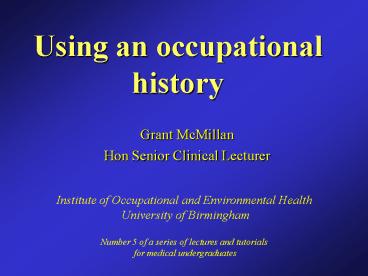Using an occupational history PowerPoint PPT Presentation
Title: Using an occupational history
1
Using an occupational history
Grant McMillan Hon Senior Clinical Lecturer
Institute of Occupational and Environmental
Health University of Birmingham Number 5 of a
series of lectures and tutorials for medical
undergraduates
2
This is a self-help tutorial designed to provide
you with an introduction to using an occupational
history to help you determine if your patient has
an occupational disease.
3
Categories of work-related diseases
- I Work the cause
- II Work a causal factor in diseases of common
occurrence - III Work provoking or aggravating an
established disease - IV Work offering ready access to potential
dangers
4
Criteria for diagnosing an occupational/work-relat
ed disease
- Effect
- Exposure
- Time sequence
- Competing causes
- Biological plausibility
- Each of these is now considered in turn
5
Effect
- Describe the effect ie presence of symptoms and
signs. - Does this fit the case definition of an accepted
work-related disease? - Have you found other cases?
6
Exposure
- Exposure must be sufficient to cause the disease
- From the history, occupational hygiene records
or by monitoring determine - What? Nature of hazard
- How much? Dose received
- Is this sufficient to cause harm?
7
Exposure
- Now, compare measured or recorded dose against
published exposure limits to determine if
exposure could be expected to cause effects.
Remember that some people are unusually sensitive
to some hazardous agents.
8
Time sequence
- Exposure must be prior to onset of illness.
- Immediate effects eg hydrogen cyanide
- Hours delay of effects eg phosgene, oxides of
nitrogen, arc eye. - Weeks or months delay of effects dermatitis,
asthma - For cancers - appropriate latency period
9
Consider non-occupational causes
- What is differential diagnosis?
- Non-occupational causes
- Environmental
- Social (smoking, alcohol, hobbies, pets)
- Family history/genetic
- Other employment
10
Consider the biological plausibility of your
diagnosis.
- Does it fit in with what you know about the
causation and nature of diseases?
PowerShow.com is a leading presentation sharing website. It has millions of presentations already uploaded and available with 1,000s more being uploaded by its users every day. Whatever your area of interest, here you’ll be able to find and view presentations you’ll love and possibly download. And, best of all, it is completely free and easy to use.
You might even have a presentation you’d like to share with others. If so, just upload it to PowerShow.com. We’ll convert it to an HTML5 slideshow that includes all the media types you’ve already added: audio, video, music, pictures, animations and transition effects. Then you can share it with your target audience as well as PowerShow.com’s millions of monthly visitors. And, again, it’s all free.
About the Developers
PowerShow.com is brought to you by CrystalGraphics, the award-winning developer and market-leading publisher of rich-media enhancement products for presentations. Our product offerings include millions of PowerPoint templates, diagrams, animated 3D characters and more.

